Track
Ever been stuck typing sudo before every Docker command? This is the article for you.
By default, Docker locks down access to its daemon, letting only root and docker group members run commands. This keeps your system safer, but it's annoying when you're working with containers all day. The docker group exists for exactly this reason - to let you use Docker without sudo passwords slowing you down.
When you add yourself to the docker group, you'll notice the difference right away. You can run docker build, docker run, and other commands without those permission errors or password prompts.
In this article, you'll learn exactly how to add users to the docker group on different systems, what security risks to watch for, and how to protect your system while making Docker easier to use.
> LLMs are getting all the hype in 2025. Follow this step-by-step guide for LLM application deployment using Docker.
Understanding The Docker Group
When you start working with Docker, you'll soon bump into permission issues if you haven't set things up right.
Let's break down what the docker group actually is and why it matters for your workflow.
Definition and functionality
The docker group is a system user group that gives members permission to use the Docker daemon without needing sudo privileges.
When you install Docker on Linux systems, this group is usually created automatically. Docker's socket file (/var/run/docker.sock) is owned by root but has group permissions set to the docker group, which is how this access control works.
Users in this group can build images, run containers, manage networks, and perform other Docker operations without prefixing commands with sudo. This means less typing and no password prompts when you're working with containers. If you try to run Docker commands without being in this group, you'll get "permission denied" errors, ultimately leading to slowing down your progress.
Security implications of group membership
Adding users to the docker group comes with real security risks you shouldn't ignore.
Members of the docker group can gain root privileges on the host system. This happens because Docker allows you to mount host directories into containers, including sensitive system directories. A user with Docker access can create a container that mounts the entire root filesystem and modify any file on the host.
Container breakout vulnerabilities pose another risk, as they might allow attackers to escape container isolation.
You should only add trusted users to the docker group, and even then, consider it equivalent to giving them root access. Many security professionals recommend limiting docker group membership to only those users who absolutely need it for their daily work.
Step-By-Step Implementation
Now that you understand what the docker group is and its implications, let's get your hands dirty with the actual setup.
Creating the docker group
In most cases, you won't need to create the docker group manually since it's automatically created during Docker installation. You can check if the group exists by running:
grep docker /etc/group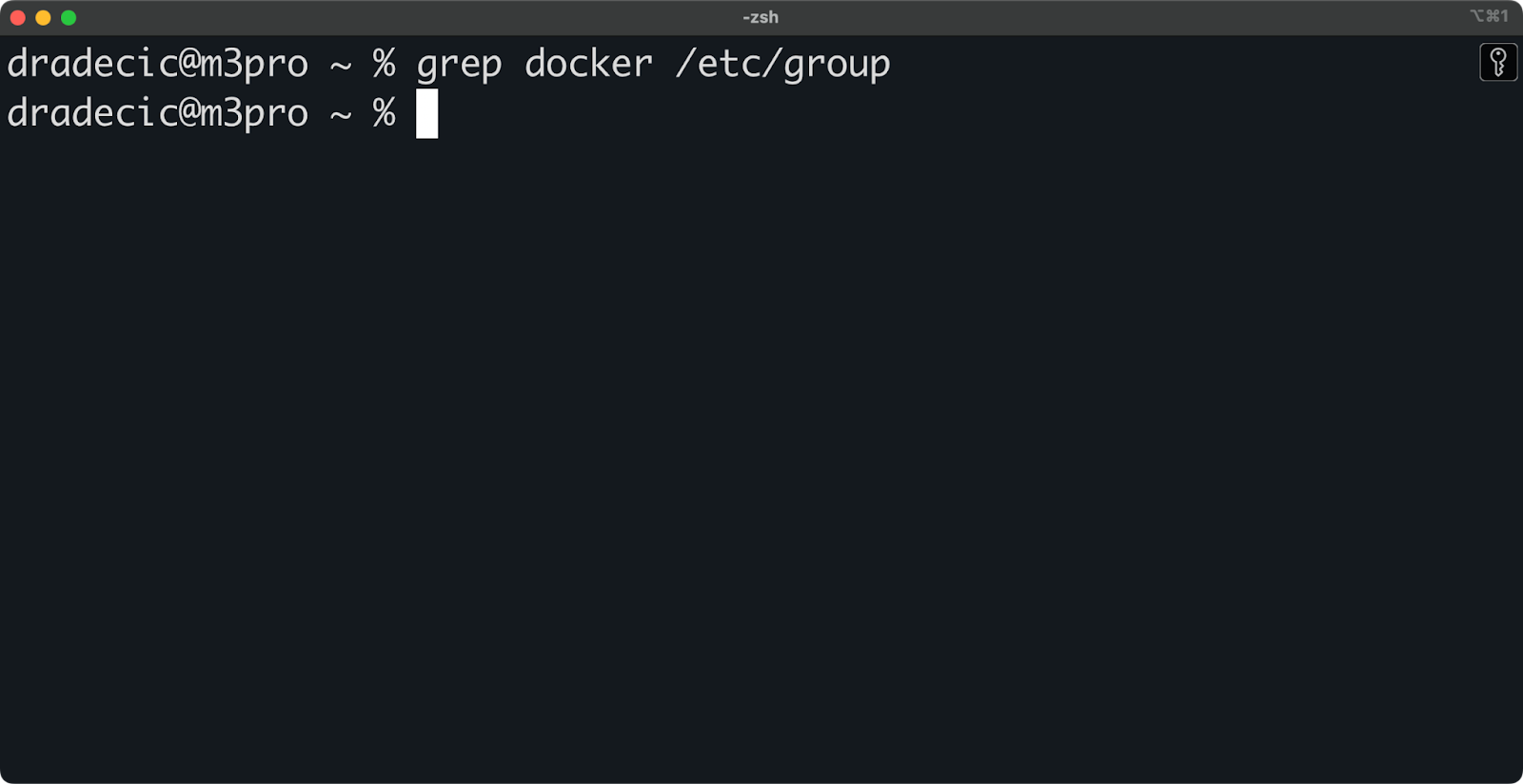
Image 1 - Checking if the docker group exists
If, for some reason, the group doesn't exist (like in my case), you can create it with this command (for Linux only):
sudo groupadd dockerThis command creates the docker group on your system, but is limited to Linux operating systems.
For macOS, you can follow official instructions from Apple, as the group is created through GUI. The process is similar for Windows operating systems.
After following the steps, you should see your group created:
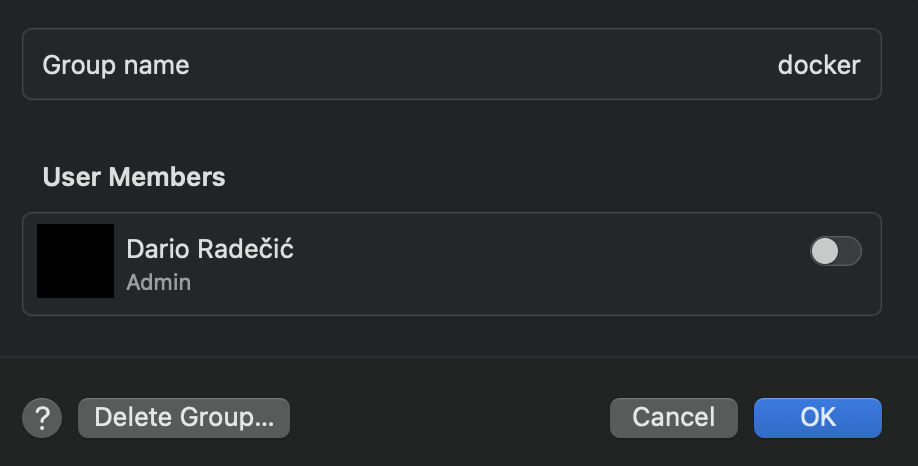
Image 2 - Checking if the docker group exists (2)
Adding users to the group
To add your current user to the docker group, run this command on Linux operating systems:
sudo usermod -aG docker $USERThe -a flag means "append" and -G specifies the group you want to add the user to. The $USER variable automatically uses your current username.
For macOS and Windows, you can add users to the group through System settings or Control panel - just toggle a switch to add all the users you wish:
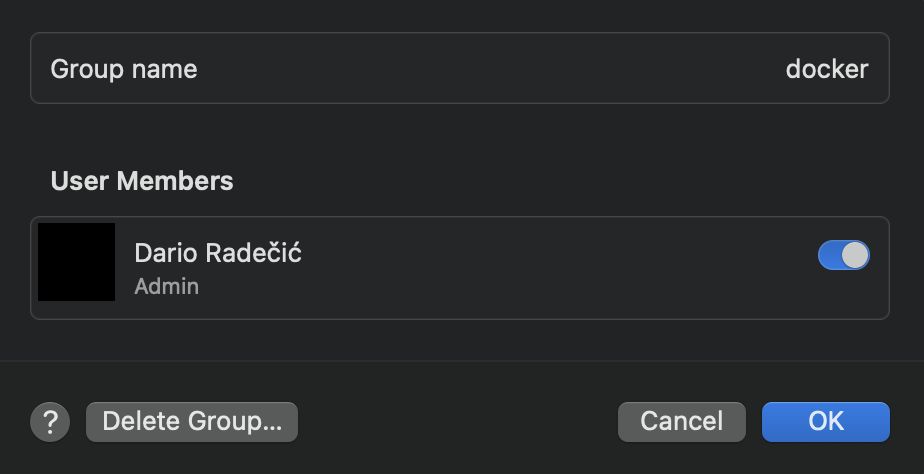
Image 3 - Adding users to the group
After adding yourself to the group, you must log out and back in for the changes to take effect. Your current session won't recognize the new group membership until you log out completely. For some systems, you might need to restart:
sudo rebootTo verify your user is now part of the docker group, run:
groupsYou should see "docker" listed among your group memberships:
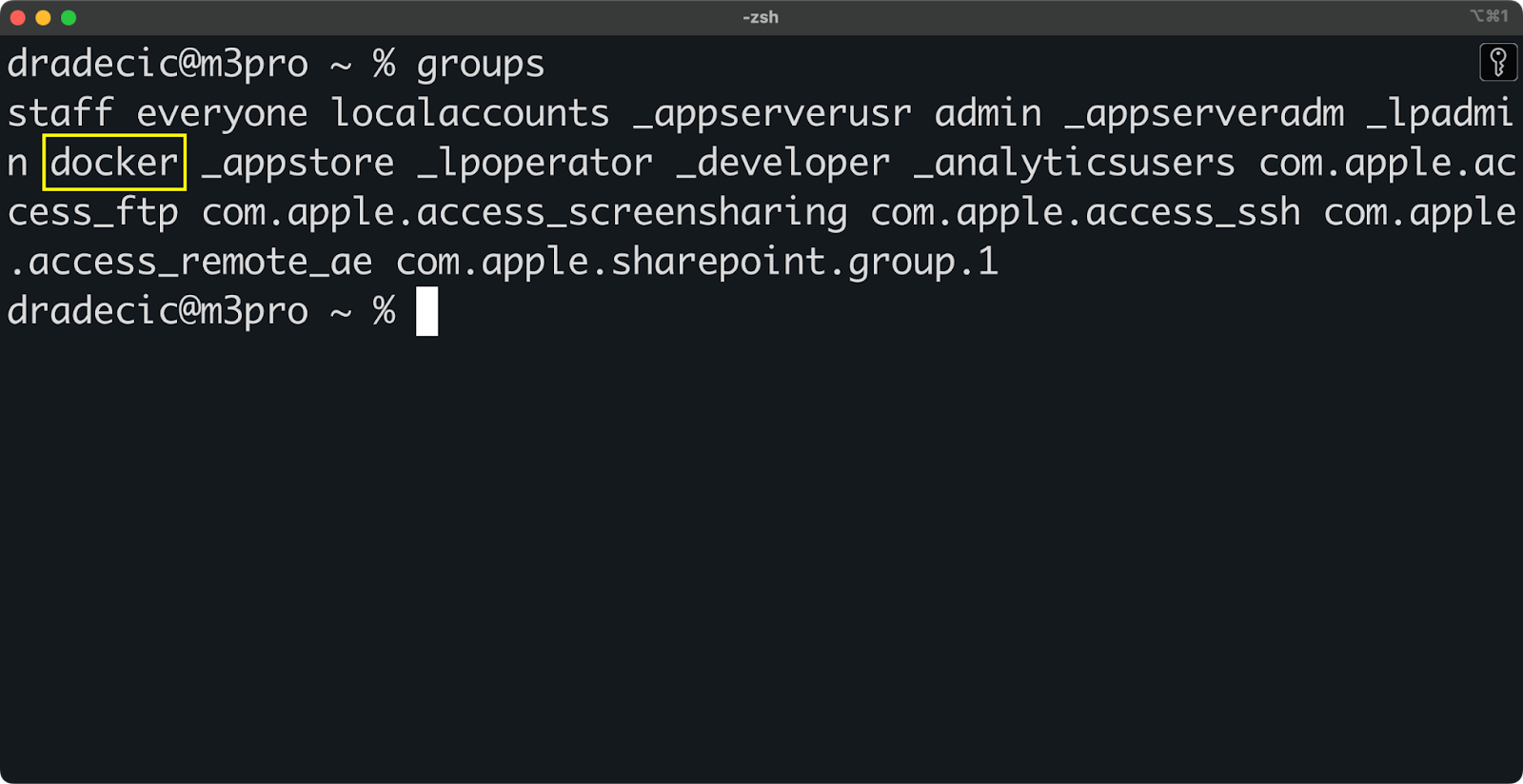
Image 4 - Viewing user groups
Troubleshooting common issues
If you still get "permission denied" errors after adding yourself to the group, you might need to fix the Docker socket permissions:
sudo chown root:docker /var/run/docker.sock
sudo chmod 660 /var/run/docker.sockAnother common issue happens when the Docker service restarts, which can reset socket permissions. If Docker was started after you made group changes, try restarting the Docker service:
sudo systemctl restart dockerFor persistent permission problems, check that your Docker service configuration is correct. On some systems, Docker might be configured to use a different group name or socket location. You can check the Docker daemon configuration file at /etc/docker/daemon.json or service files in /lib/systemd/system/docker.service.
Remember that any permission changes you make will apply to your current login session only after you log out and back in. This is the number one cause of "I made the changes, but it's still not working" problems.
Security Considerations And Mitigations
Adding users to the docker group can create security risks, which you need to be aware of. Let's examine these risks and what you can do to protect your systems.
Risks of docker group membership
Docker group membership is practically the same as having root access to your system. This isn't an exaggeration – it's the reality of how Docker works.
When you're in the docker group, you can run containers that mount sensitive parts of your host filesystem. For example, this simple command gives you complete access to modify any file on your host:
docker run -it --rm -v /:/hostroot alpine chroot /hostrootYou can also change Docker daemon settings, create privileged containers, or use host network mode to bypass network isolation. These capabilities let malicious users (or compromised applications with Docker access) completely take over your host system.
There are a couple of other potential risks you must know:
- Running containers that access hardware devices directly.
- Binding to low-numbered network ports.
- Starting containers with custom seccomp profiles that disable security controls.
- Creating containers that use the host's process namespace.
Each of these can be abused to gain elevated privileges or disrupt system operations.
Best practices for risk mitigation
To reduce these risks, follow the principle of least privilege—only grant docker group membership to users who absolutely need it. If multiple people need to use a shared system, consider creating a separate user account just for Docker operations.
Docker's rootless mode offers a more secure alternative to the docker group approach. Rootless mode lets you run the Docker daemon and containers as a non-root user, without requiring membership in any special group:
# Install Docker in rootless mode
dockerd-rootless-setuptool.sh install
# Start the rootless Docker daemon
systemctl --user start dockerUser namespaces provide another layer of security by mapping container UIDs to a different range on the host. This means even if a container runs as root (UID 0), that process maps to an unprivileged user on the host:
# Add to /etc/docker/daemon.json
{
"userns-remap": "default"
}Consider using static UID/GID allocation for container users to maintain consistent identity mapping. In your Dockerfiles, create specific users with predetermined IDs:
# Create a user with a static UID/GID
RUN groupadd -g 10001 appgroup && \
useradd -u 10000 -g appgroup -s /bin/bash appuser
# Switch to that user
USER appuserRegularly audit who has docker group membership with commands like:
getent group dockerAnd remove users who no longer need access:
sudo gpasswd -d username dockerIn combination, these approaches give you and your team the convenience of docker group membership while minimizing the security risks it introduces.
Advanced Configuration And Alternatives
If you're looking for different ways to manage Docker access beyond the standard group membership approach, you've got options. Let's explore some advanced configurations and alternatives that might better fit your security requirements.
Dockerfile security hardening
You can build security directly into your Dockerfiles to reduce the risks even when users have docker group access.
In the example below, I'll be using multi-stage builds to keep your Python images small and reduce attack surface.
To follow along, create these files:
app.py:
from flask import Flask, jsonify
app = Flask(__name__)
@app.route("/api/health")
def health():
return jsonify({"status": "healthy"})
if __name__ == "__main__":
app.run(host="0.0.0.0", port=8000, debug=True)requirements.txt:
flask==3.1.0Dockerfile:
FROM python:3.13-slim AS builder
WORKDIR /app
COPY requirements.txt .
RUN pip install --no-cache-dir -r requirements.txt
FROM python:3.13-slim
WORKDIR /app
COPY --from=builder /usr/local/lib/python3.13/site-packages /usr/local/lib/python3.13/site-packages
COPY . .
RUN useradd -r -u 1000 -g users appuser
USER appuser
CMD ["python", "app.py"]In a nutshell, this Dockerfile includes a USER instruction with a non-root user and copies relevant content (Python packages) from a previous build step.
> If you're new to containerizing applications, fear not - our complete guide has you covered.
You can build and run such a container with the following commands:
# Build the image
docker build -t my-python-app .
# Run the container
docker run --cap-drop=ALL --cap-add=NET_BIND_SERVICE my-python-app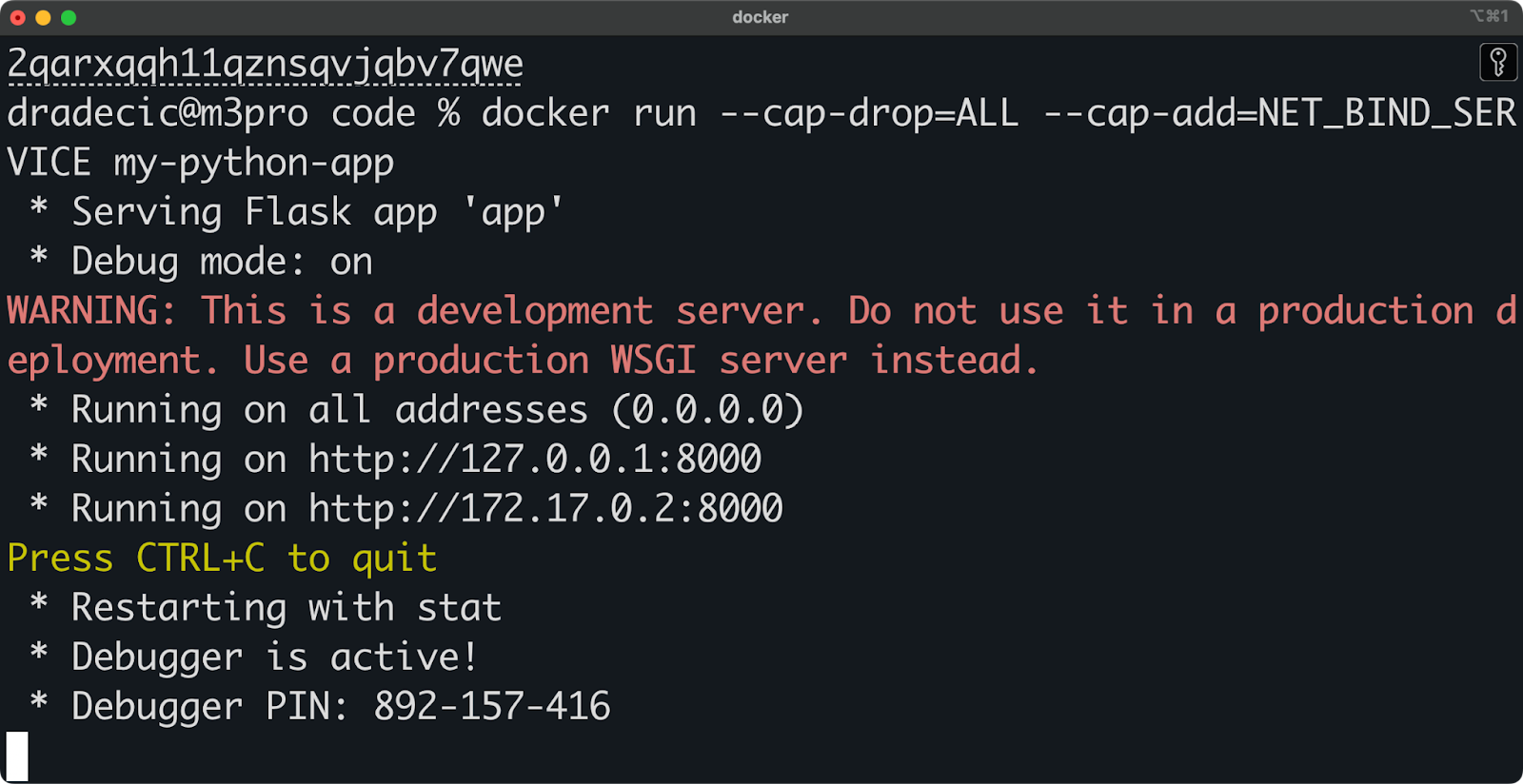
Image 5 - Running a container with minimal privileges
The newly added command - --cap-drop=ALL - drops all Linux capabilities from the container (restricts privileges), while the --cap-add=NET_BIND_SERVICE command adds back the NET_BIND_SERVICE capability which allows the container to bind to low-numbered ports.
These techniques limit what a container can do, even if someone with docker group access tries to misuse it.
sudo as an alternative
If you don't want to add users to the docker group, using sudo is a viable alternative. This approach gives you more control and an audit trail of Docker commands.
You can create a custom sudoers entry that allows specific users to run only Docker commands without a password:
# Add to /etc/sudoers.d/docker
username ALL=(root) NOPASSWD: /usr/bin/dockerFor better usability, create aliases in your .bashrc or .zshrc file:
alias docker='sudo docker'
alias docker-compose='sudo docker-compose'This sudo approach offers better security because:
- You get all Docker commands logged in the system logs.
- You can restrict which Docker subcommands are allowed.
- Users can't modify the Docker daemon configuration.
The downside is slightly more typing and potential issues with tools that expect direct Docker access.
Windows considerations
Windows handles Docker permissions differently than Linux. Instead of the docker group, Windows uses the docker-users group.
To add a user to the docker-users group on Windows, do this:
- Open Computer Management (right-click on Start and select "Computer Management").
- Navigate to System Tools > Local Users and Groups > Groups.
- Double-click on "docker-users".
- Click "Add" and enter the username.
- Click "OK" and close Computer Management.
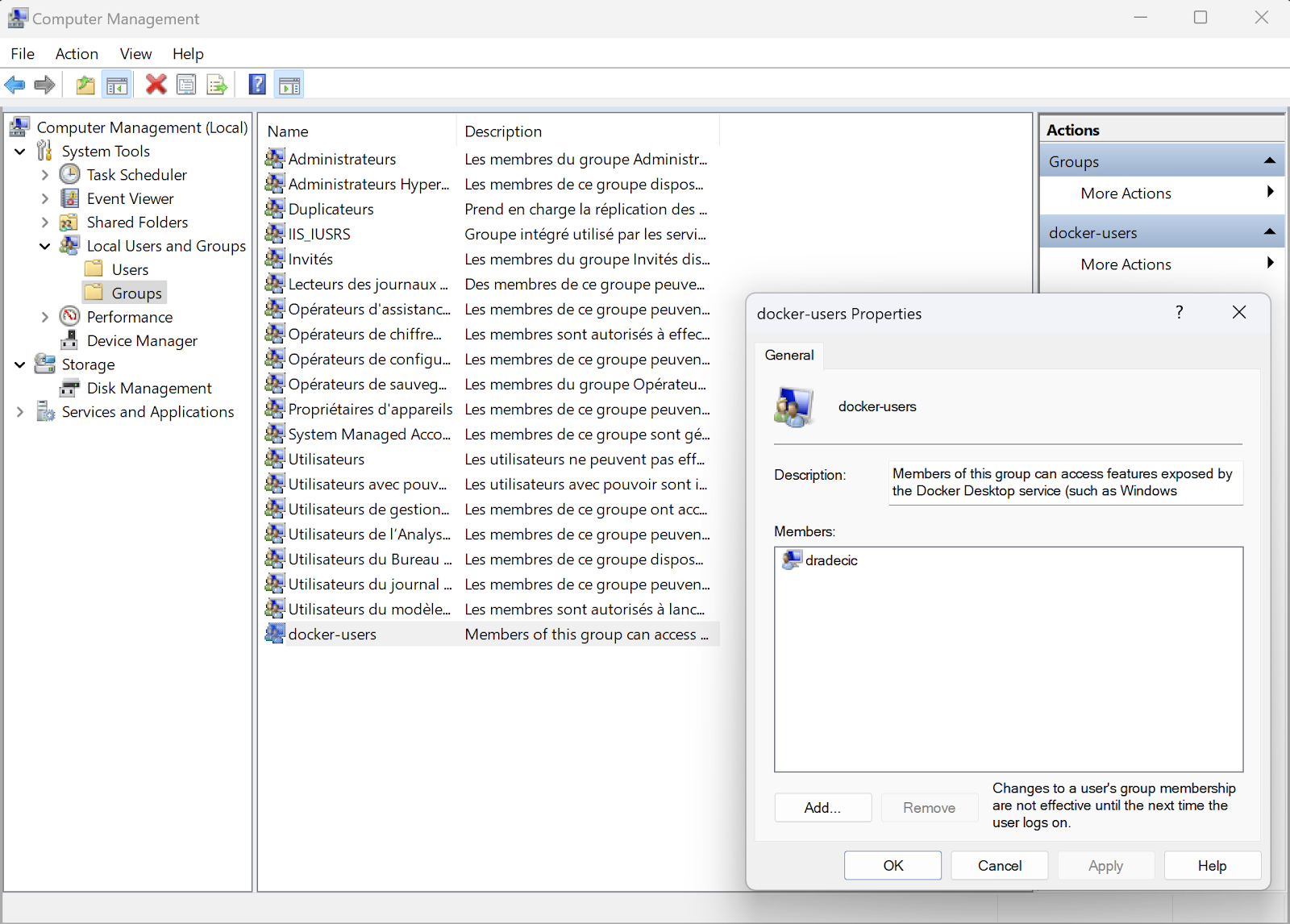
Image 6 - User groups on Windows
Alternatively, you can use PowerShell with administrator privileges:
Add-LocalGroupMember -Group "docker-users" -Member "username"After adding a user, they'll need to log out and back in for the changes to take effect, just like on Linux.
It's also worth noting that Windows offers additional security features through Windows Defender Application Control and Hyper-V isolation modes that aren't available on Linux. For high-security environments on Windows, you can use these features to create stronger boundaries between containers and the host.
> Data professionals need Docker in 2025, and this guide will show you how to learn it.
Summing up Docker User Groups
You've now got the complete picture of how to add users to the docker group and why it matters. Let's recap what we've covered.
Adding users to the docker group makes working with containers much easier by removing the need for sudo commands. It's a simple process: check if the group exists, add your user with usermod -aG docker $USER, and then log out and back in. If you hit problems, check your socket permissions and restart Docker.
But don't forget that giving someone docker group access is almost the same as handing them the root password. Anyone in this group can mount your entire filesystem, install software, or even modify system files through containers. That's why it's crucial to be selective about who gets this access.
So what's the right approach for your environment?
In general, for developers working on their own machines, docker group membership is fine. For shared servers or production environments, consider alternatives like rootless mode, user namespaces, or using sudo with limited commands. And whatever you do, always follow security best practices in your Dockerfiles by using non-root users and dropping unnecessary capabilities.
Keep an eye on who has docker group access by running regular audits. People change roles, leave teams, or simply stop needing certain permissions over time. A quick check with getent group docker can help you spot users who shouldn't be there anymore.
If you want to learn more about Docker and containerization in general, these DataCamp courses are your best next stop:
Master Docker and Kubernetes
FAQs
What is the Docker group, and why does it matter?
The Docker group is a system user group that grants members permission to use the Docker daemon without sudo privileges. It exists to make Docker commands more convenient by eliminating password prompts and permission errors. When you install Docker on Linux systems, this group is automatically created and controls access to the Docker socket file. Adding users to this group lets them run all Docker commands directly, which greatly improves workflow efficiency.
What security risks come with Docker group membership?
Docker group membership effectively grants root-equivalent access to your system. Members can mount the host filesystem inside containers, modify system files, and potentially gain full administrative access. They can also change Docker daemon configurations and run privileged containers with direct hardware access. This level of access makes it crucial to only add trusted users to the Docker group and to follow additional security hardening measures.
Can I use Docker without adding users to the Docker group?
Yes, you can use Docker without adding users to the Docker group. The most common alternative is using sudo before each Docker command, which provides better security and auditing capabilities. Another option is setting up Docker's rootless mode, which allows running the daemon and containers as a non-root user. You can also create custom sudoers entries that allow specific users to run only Docker commands without a password.
How do I verify if a user was successfully added to the Docker group?
You can verify successful addition to the Docker group by running the command groups $USERNAME to list all groups the user belongs to. If "docker" appears in the list, the user is a member. Alternatively, you can check with getent group docker to see all members of the Docker group. Remember that users must log out and back in before new group memberships take effect, which is a common troubleshooting point.
How does Docker group management differ on Windows compared to Linux?
Windows uses a "docker-users" group instead of the "docker" group found on Linux systems. On Windows, you add users through Computer Management or PowerShell with administrator privileges using the Add-LocalGroupMember command. Unlike Linux, Windows offers additional security through Windows Defender Application Control and Hyper-V isolation modes. However, just like on Linux, users must log out and log back in after being added to the group for changes to take effect.




